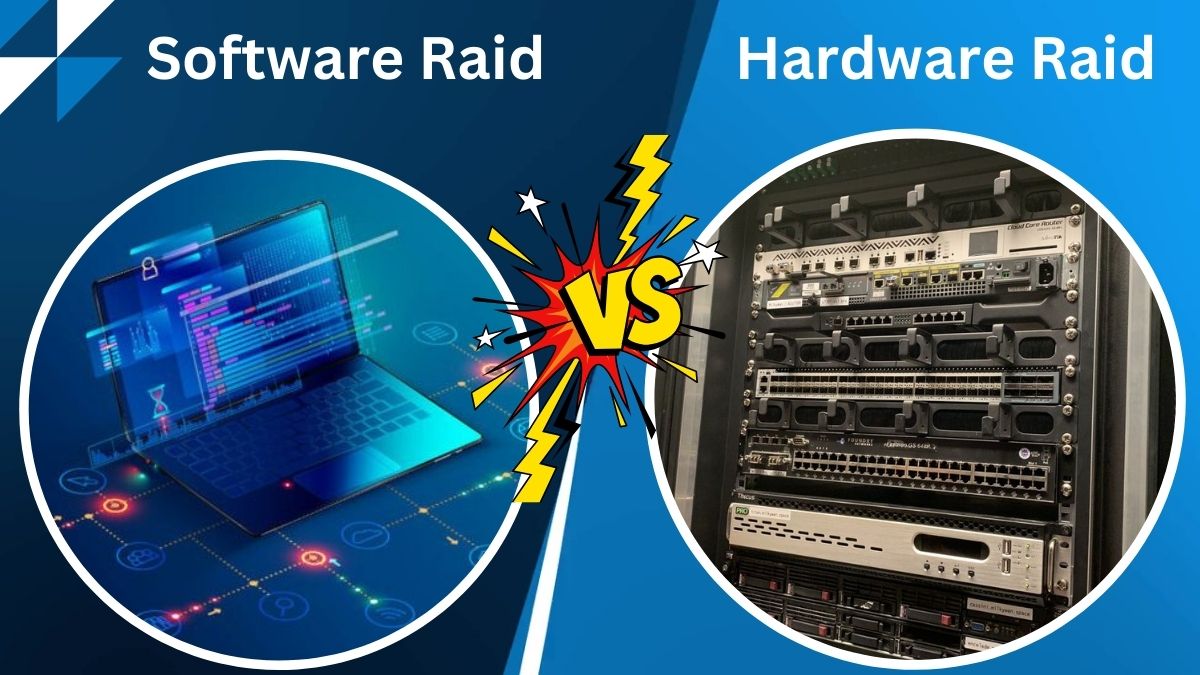Are you trying to decide between hardware and software RAID for storing your data but finding it confusing? Don’t worry, we’re here to help simplify this decision and help you choose between two methods to keep your digital stuff safe.
Hardware RAID is like having a particular boss (controller) that carefully organizes your data, just like a conductor leading a musical performance. On the other hand, software RAID is like using clever computer programs and your computer’s abilities to protect your digital files. So, if you want to learn more about these two options and make the right choice for your data, keep reading. We will explain everything about hardware RAID and software RAID, and soon, you’ll be a pro at deciding which one is best for you.
Table of Contents
ToggleHardware Raid vs Software Raid
RAID, which stands for Redundant Array of Independent Disks, is a method of storing data across multiple hard disks to ensure data redundancy and improve performance. It can be implemented through hardware or software, leading to Hardware and Software RAID. Hardware RAID is configured via the motherboard or a separate RAID card and operates independently from the host system.
On the other hand, software RAID is implemented through the operating system without any specialized hardware. Both have advantages and disadvantages in terms of cost, performance, flexibility, and reliability, and the choice between them depends on specific use cases and requirements.
YOU MIGHT ALSO LIKE: Can You Connect Roku to TV Without HDMI?
How Do Hardware Raid and Software Raid Work?
There are two primary approaches to implementing RAID: hardware and software.
Hardware RAID employs dedicated RAID controller cards installed separately in a computer or server. These controllers manage the RAID array independently, supporting various RAID levels (e.g., RAID 0, RAID 1, RAID 5). Configuration occurs through a BIOS or firmware interface, separate from the OS.
Hardware RAID generally delivers robust performance, thanks to the dedicated controller, and often supports features like hot-swapping. However, data recovery can be complex if the controller fails. Software RAID operates at the OS level without dedicated hardware.
The OS manages the RAID array using software drivers, offering flexibility in configuration and maintenance. Although software RAID may be less efficient due to reliance on the host system’s CPU, it can be more adaptable and cost-effective.
Data recovery is typically straightforward since RAID metadata is stored on the disks, simplifying recovery during a system failure. The choice between hardware and software RAID depends on specific needs, budget, and system architecture.
Pros and Cons of Hardware Raid vs Software Raid
Hardware RAID and software RAID are two approaches to achieving data redundancy and performance improvement in storage systems. Below are the pros and cons of each:
Hardware RAID
Pros
Performance: Hardware RAID controllers often have dedicated processors and cache memory, which can lead to better performance compared to software RAID.
Ease of Management: Hardware RAID controllers typically come with user-friendly management interfaces and tools, making setting up and monitoring your RAID arrays easier.
Hot Swapping: Many hardware RAID setups support hot-swappable drives, allowing you to replace a failed drive without shutting down the system.
RAID Levels: Hardware RAID controllers often support a more comprehensive range of RAID levels, including more complex configurations like RAID 5, 6, and 10.
Stability: Hardware RAID is generally considered more stable and reliable because it operates independently of the host system’s CPU and OS.
Cons
Cost: Hardware RAID controllers can be expensive in terms of the controller card itself and the specific drives they require.
Vendor Lock-In: Hardware RAID may tie you to a specific vendor, making it more challenging to switch or upgrade without replacing the entire controller.
Limited Flexibility: Hardware RAID configurations can be less flexible regarding expanding or modifying arrays, especially if using a proprietary controller.
Software RAID
Pros
Cost: Software RAID is usually more cost-effective since it doesn’t require specialized hardware. It can be implemented using the existing hardware of your system.
Flexibility: Software RAID is often more flexible regarding array expansion and modification. You can use a broader range of hard drives and mix and match sizes and brands.
Platform Independence: Software RAID can work on various operating systems and is not tied to specific hardware vendors.
Easy Migration: If you switch hardware or need to move your RAID setup to a different system, software RAID can be easier to migrate.
Cons
Performance: Software RAID can be less efficient regarding CPU usage because it relies on the host system’s processing power for calculations.
Complexity: Setting up and managing software RAID can be more complex, requiring a good understanding of the operating system’s implementation.
Lack of Advanced Features: Some advanced RAID levels and features (e.g., RAID 5 and 6) may not be as readily available in software RAID implementations.
Dependency on OS: Software RAID is tied to the operating system, so if the OS fails, it can impact the RAID setup.
What Is the Best Option? A software raid or a hardware raid?
The choice between software and hardware RAID hinges on various factors. Software RAID is cost-effective and versatile, suiting multiple hardware setups. However, it may impact system performance as it relies on the CPU for processing.
In contrast, hardware RAID offers better performance as it offloads processing to a dedicated controller, but it can be expensive and less flexible regarding hardware compatibility. It typically comes with a management interface, simplifying setup and monitoring. Hardware RAID also excels in immediate fault notification and recovery, often supporting hot-swappable drives for ease of replacement.
Software RAID is a practical choice for cost-conscious users with basic requirements and flexible hardware. On the other hand, hardware RAID suits those demanding high performance, advanced features, and immediate fault recovery, albeit at a higher cost and potential compatibility constraints.
Final Thoughts
Hardware RAID offers superior performance, ease of management, and immediate fault recovery but can be expensive and less flexible regarding hardware compatibility. Software RAID is cost-effective, flexible, and platform-independent, although it may impact system performance.
A hybrid approach may suit those seeking a balance between price and performance. Ultimately, the best option varies based on your unique circumstances and requirements.










